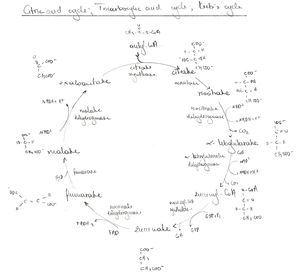Citric acid cycle, amphibolic character of the citric acid cycle, regulation
The Citric Acid cycle and the catabolism of Acetyl-CoA[edit | edit source]
The Citric acid cycle (aka Kreb's cycle and Tricarboxylic acid cycle-TCA cycle) is a sequence of reactions, of an amphibolic overall nature (both catatbolic and anabolic), occurring in mitochondrial matrix that oxidizes acetyl moieties of acetyl-CoA. It is the final common pathway for oxidation of carbohydrate, protein and lipids as glucose, fatty acids and amino acids are metabolized to acetyl-CoA or intemediates of the cycle. The cycle starts with anabolic condensation of acetyl-CoA (3C) and oxaloacetate(3C), to yield citric acid (6C), the tricarboxylic acid of the cycle. In the subsequent catabolic reactions two molecules of CO2 are released (in the isocitrate dehydrogenase and a-ketoglutarate dehydrogenase complex steps) and oxaloacetate is regenerated, commencing another cycle. The enzymes of the cycle are located in the mitochondrial matrix either free or bound to the inner mitochondrial membrane where the enzymes of the respiratory chain and oxidative phosphorylation are also found. The molecule citrate is a prochiral molecule, and in order to generate it, oxaloacetate must first bind to citrate synthase, followed by an incoming acetyl CoA.
Energy yield per turn of the cycle[edit | edit source]
As a result of the redox reactions in the TCA cycle, three molecules of NADH+H+ and one of FADH2 are produced per molecule of acetyl-CoA catabolized in one turn of the cycle. The total energy yield per turn of the TCA cycle is 10 ATP.
- Reoxidation of NADH+H+ back to NAD+ by the NADH-Q oxidoreductase/complex I enzyme of the respiratory chain results in the formation of 2,5 ATP
- Reoxidation of FADH2 back to FAD by the succinate-Q reductase/complex II enzyme of the respiratory chain results in the formation of 1,5 ATP
- 1 ATP or 1 GTP is formed directly by substrate level phosphorylation catalyzed by the TCA cycle enzyme syccinyl-CoA synthase.
Vitamins and TCA cycle[edit | edit source]
Many water soluble vitamins are fundamental components of the major constiruents of the citric acid cycle.
- Vitamin B1/Thiamin: component of Thiamine Diphosphate-ThDP, a coenzyme of the α-ketoglutarate dehydrogenase enzyme
- Vitamin B2/Riboflavin: component of Flavin Adenine Dinucleotide-FAD, an electron transporter coenzyme
- Vitamin B3/Niacin: component of Nicotinamide Adenine Dinucleotide-NAD+, an electron transporter coenzyme
- Vitamin B5/Pantothenic acid: component of coenzyme A
Links[edit | edit source]
Bibliography[edit | edit source]
MURRAY, Robert K. – BENDER, David A.. Harper's Illustrated Biochemistry. 29th edition. McGraw-Hill Companies, Inc., 2012. ISBN 978-0-07-176576-3.

